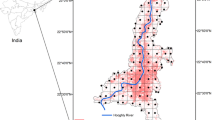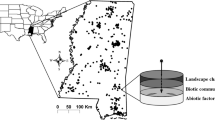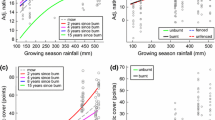Abstract
Native species richness is often significantly correlated with exotic species richness, but the direction and strength of this so-called native-exotic richness relationship (NERR) differs among studies. Furthermore, the potential influence of biotic and abiotic co-variates is less commonly considered. Our objectives were to determine (i) how two different components of scale, grain, and extent, influence the NERR, and (ii) if and how biotic and abiotic variables moderate the NERR. We addressed these objectives using data collected at 37 sites within the endangered Purshia tridentata Pursh (DC) (antelope-brush) shrub-steppe grasslands in southern British Columbia, Canada. We found a significantly positive NERR at our finest grain (1 m2), but no significant NERR at any of the three broader grains (10, 100, and 1,000 m2). Changing the extent of analysis did not affect the NERR. A multi-model inference approach revealed, at fine grains, (i) strong support for native species richness as a positive predictor of exotic species richness, (ii) Bromus tectorum L. (cheatgrass) as an important negative predictor of native species richness, (iii) foliar cover of P. tridentata as an important positive predictor of exotic species cover, and (iv) a limited predictive role for soil properties. We speculate that spatial patterning in the importance of facilitation relative to competition could influence the NERR within semi-arid ecosystems such as ours. Last, to facilitate comparative research and meta-analyses, we highlight the need for future research to be more explicit in its description of scale, and to more clearly define the grain and extent of each analysis.


Similar content being viewed by others
References
Bangert R, Huntly N (2010) The distribution of native and exotic plants in a naturally fragmented sagebrush-steppe landscape. Biol Invasions 12:1627–1640
Barton K (2011) MuMIn: multi-model inference. R package version 1.0.0. http://CRAN.R-project.org/package=MuMIn
Bashkin M, Stohlgren TJ, Otsuki Y, Lee M, Evangelista P, Belnap J (2003) Soil characteristics and plant exotic species invasions in the grand staircase—Escalante National Monument, Utah, USA. Appl Soil Ecol 22:67–77
Brooks ML, Berry KH (2006) Dominance and environmental correlates of alien annual plants in the Mojave Desert, USA. J Arid Environ 67(Supplement):100–124
Bruno JF, Stachowicz JJ, Bertness MD (2003) Inclusion of facilitation into ecological theory. Trends Ecol Evol 18:119–125
Callaway RM, Brooker RW, Choler P, Kikvidze Z, Lortie CJ, Michalet R, Paolini L, Pugnaire FI, Newingham B, Aschehoug ET, Armas C, Kikodze D, Cook BJ (2002) Positive interactions among alpine plants increase with stress. Nature 417:844–848
Chen H, Qian H, Spyreas G, Crossland M (2010) Native-exotic species richness relationships across spatial scales and biotic homogenization in wetland plant communities of Illinois, USA. Divers Distrib 16:737–743
D’Antonio CM, Vitousek PM (1992) Biological invasions by exotic grasses, the grass/fire cycle, and global change. Annu Rev Ecol Syst 23:63–87
Davies KF, Chesson P, Harrison S, Inouye BD, Melbourne BA, Rice KJ (2005) Spatial heterogeneity explains the scale dependence of the native-exotic diversity relationship. Ecology 86:1602–1610
Elton CS (1958) The ecology of invasions by animals and plants. Methuen, London
Flores J, Jurado E (2003) Are nurse-protege interactions more common among plants from arid environments? J Veg Sci 14:911–916
Freckleton RP (2011) Dealing with collinearity in behavioural and ecological data: model averaging and the problems of measurement error. Behav Ecol Sociobiol 65:91–101
Fridley JD, Stachowicz JJ, Naeem S, Sax DF, Seabloom EW, Smith MD, Stohlgren TJ, Tilman D, Von Holle B (2007) The invasion paradox: reconciling pattern and process in species invasions. Ecology 88:3–17
Griffith AB (2010) Positive effects of native shrubs on Bromus tectorum demography. Ecology 91:141–154
Huntly N, Bangert R, Hanser SE (2011) Native and exotic plants of fragments of sagebrush steppe produced by geomorphic processes versus land use. Plant Ecol 212:1549–1561
Iverson K, Haney A (2006) Updated ecosystem mapping for the South Okanagan Valley. British Columbia Ministry of Water, Land, and Air Protection, Victoria
Johnson JB, Omland KS (2004) Model selection in ecology and evolution. Trends Ecol Evol 19:101–108
Jones JB (2001) Laboratory guide for conducting soil tests and plant analysis. CRC Press, Boca Raton
Kalkhan MA, Stafford EJ, Woodly PJ, Stohlgren TJ (2007) Assessing exotic plant species invasions and associated soil characteristics: a case study in eastern Rocky Mountain National Park, Colorado, USA, using the pixel nested plot design. Appl Soil Ecol 35:622–634
Kolb A, Alpert P, Enters D, Holzapfel C (2002) Patterns of invasion within a grassland community. J Ecol 90:871–881
Krannitz PG (2008) Response of antelope bitterbrush shrubsteppe to variation in livestock grazing. West North Am Naturalist 68:138–152
Lea T (2008) Historical (pre-settlement) ecosystems of the Okanagan Valley and Lower Similkameen Valley of British Columbia: pre-European contact to the present. Davidsonia 19:3–36
Lea T, Flynn S, Cadrin C (2004) Antelope-brush/needle-and-thread grass (Purshia tridentata/Hesperostipa comata). British Columbia Ministry of Water, Land, and Air Protection, Victoria
Levine JM, D’Antonio CM (1999) Elton revisited: a review of evidence linking diversity and invasibility. Oikos 87:15–26
Lilley PL, Vellend M (2009) Negative native-exotic diversity relationship in oak savannas explained by human influence and climate. Oikos 118:1373–1382
MacDougall AS, Boucher J, Turkington R, Bradfield GE (2006) Patterns of plant invasion along an environmental stress gradient. J Veg Sci 17:47–56
Melbourne BA, Cornell HV, Davies KF, Dugaw CJ, Elmendorf S, Freestone AL, Hall RJ, Harrison S, Hastings A, Holland M, Holyoak M, Lambrinos J, Moore K, Yokomizo H (2007) Invasion in a heterogeneous world: resistance, coexistence or hostile takeover? Ecol Lett 10:77–94
Mitchell CE, Agrawal AA, Bever JD, Gilbert GS, Hufbauer RA, Klironomos JN, Maron JL, Morris WF, Parker IM, Power AG, Seabloom EW, Torchin ME, Vazquez DP (2006) Biotic interactions and plant invasions. Ecol Lett 9:726–740
Murtaugh PA (2007) Simplicity and complexity in ecological data analysis. Ecology 88:56–62
Murtaugh PA (2009) Performance of several variable-selection methods applied to real ecological data. Ecol Lett 12:1061–1068
Padien DJ, Lajtha K (1992) Plant spatial pattern and nutrient distribution in pinyon-juniper woodlands along an elevational gradient in northern New Mexico. Int J Plant Sci 153:425–433
Palmer MW, Maurer TA (1997) Does diversity beget diversity? A case study of crops and weeds. J Veg Sci 8:235–240
R Development Core Team (2010) R: a language and environment for statistical computing. R Foundation for Statistical Computing, Vienna
Sandel B, Corbin JD (2010) Scale, disturbance and productivity control the native-exotic richness relationship. Oikos 119:1281–1290
Scheiner SM, Cox SB, Willig M, Mittelbach GG, Osenberg C, Kaspari M (2000) Species richness, species-area curves and Simpson’s paradox. Evol Ecol Res 2:791–802
Schielzeth H (2010) Simple means to improve the interpretability of regression coefficients. Methods Ecol Evol 1:103–113
Schwarz G (1978) Estimating the dimensions of a model. Ann Stat 6:461–464
Shea K, Chesson P (2002) Community ecology theory as a framework for biological invasions. Trends Ecol Evol 17:170–176
Shinneman DJ, Baker WL (2009) Environmental and climatic variables as potential drivers of post-fire cover of cheatgrass (Bromus tectorum) in seeded and unseeded semiarid ecosystems. Int J Wild Fire 18:191–202
Stohlgren TJ, Falkner MB, Schell LD (1995) A Modified-Whittaker nested vegetation sampling method. Vegetatio 117:113–121
Stohlgren TJ, Binkley D, Chong GW, Kalkhan MA, Schell LD, Bull KA, Otsuki Y, Newman G, Bashkin M, Son Y (1999) Exotic plant species invade hot spots of native plant diversity. Ecol Monogr 69:25–46
Stohlgren TJ, Barnett DT, Kartesz J (2003) The rich get richer: patterns of plant invasions in the United States. Front Ecol Environ 1:11–14
Stohlgren TJ, Guenther DA, Evangelista PH, Alley N (2005) Patterns of plant species richness, rarity, endemism, and uniqueness in an arid landscape. Ecol Appl 15:715–725
Stohlgren TJ, Jarnevich C, Chong GW, Evangelista PH (2006) Scale and plant invasions: a theory of biotic acceptance. Preslia 78:405–426
Tanentzap AJ, Bazely DR, Lafortezza R (2010) Diversity-invasibility relationships across multiple scales in disturbed forest understoreys. Biol Invasions 12:2105–2116
Warton DI, Hui FKC (2011) The arcsine is asinine: the analysis of proportions in ecology. Ecology 92:3–10
Acknowledgments
We thank Jamie McEwan, Katelyn Short, Courtney Paterson, Laura Super, and Sarah Degenhardt for the research assistance in the field and lab. We also thank John Klironomos, Bob Lalonde, Sylvie Desjardins, fellow members of the Biodiversity and Landscape Ecology Research Facility, and four anonymous reviewers for helpful comments on earlier versions of this manuscript. Funding for this research was provided by Natural Sciences and Engineering Research Council, The Nature Trust of British Columbia (BC), the Canada Foundation for Innovation, and UBC Okanagan. Land access was kindly provided by The Nature Trust of BC, Canadian Wildlife Service, BC Ministry of Environment, and several private land owners.
Author information
Authors and Affiliations
Corresponding author
Electronic supplementary material
Below is the link to the electronic supplementary material.
Rights and permissions
About this article
Cite this article
Symonds, J.E., Pither, J. Multi-scale analyses of exotic and native plant species diversity within Canada’s endangered antelope-brush ecosystem. Plant Ecol 213, 1263–1275 (2012). https://doi.org/10.1007/s11258-012-0084-7
Received:
Accepted:
Published:
Issue Date:
DOI: https://doi.org/10.1007/s11258-012-0084-7




